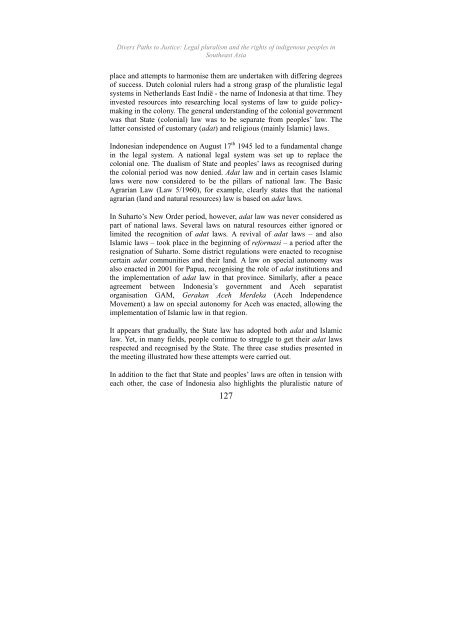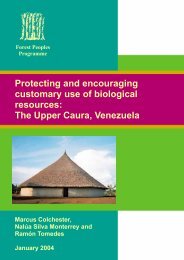Divers Paths to Justice - English - Forest Peoples Programme
Divers Paths to Justice - English - Forest Peoples Programme
Divers Paths to Justice - English - Forest Peoples Programme
You also want an ePaper? Increase the reach of your titles
YUMPU automatically turns print PDFs into web optimized ePapers that Google loves.
<strong>Divers</strong> <strong>Paths</strong> <strong>to</strong> <strong>Justice</strong>: Legal pluralism and the rights of indigenous peoples inSoutheast Asiaplace and attempts <strong>to</strong> harmonise them are undertaken with differing degreesof success. Dutch colonial rulers had a strong grasp of the pluralistic legalsystems in Netherlands East Indië - the name of Indonesia at that time. Theyinvested resources in<strong>to</strong> researching local systems of law <strong>to</strong> guide policymakingin the colony. The general understanding of the colonial governmentwas that State (colonial) law was <strong>to</strong> be separate from peoples’ law. Thelatter consisted of cus<strong>to</strong>mary (adat) and religious (mainly Islamic) laws.Indonesian independence on August 17 th 1945 led <strong>to</strong> a fundamental changein the legal system. A national legal system was set up <strong>to</strong> replace thecolonial one. The dualism of State and peoples’ laws as recognised duringthe colonial period was now denied. Adat law and in certain cases Islamiclaws were now considered <strong>to</strong> be the pillars of national law. The BasicAgrarian Law (Law 5/1960), for example, clearly states that the nationalagrarian (land and natural resources) law is based on adat laws.In Suhar<strong>to</strong>’s New Order period, however, adat law was never considered aspart of national laws. Several laws on natural resources either ignored orlimited the recognition of adat laws. A revival of adat laws – and alsoIslamic laws – <strong>to</strong>ok place in the beginning of reformasi – a period after theresignation of Suhar<strong>to</strong>. Some district regulations were enacted <strong>to</strong> recognisecertain adat communities and their land. A law on special au<strong>to</strong>nomy wasalso enacted in 2001 for Papua, recognising the role of adat institutions andthe implementation of adat law in that province. Similarly, after a peaceagreement between Indonesia’s government and Aceh separatis<strong>to</strong>rganisation GAM, Gerakan Aceh Merdeka (Aceh IndependenceMovement) a law on special au<strong>to</strong>nomy for Aceh was enacted, allowing theimplementation of Islamic law in that region.It appears that gradually, the State law has adopted both adat and Islamiclaw. Yet, in many fields, people continue <strong>to</strong> struggle <strong>to</strong> get their adat lawsrespected and recognised by the State. The three case studies presented inthe meeting illustrated how these attempts were carried out.In addition <strong>to</strong> the fact that State and peoples’ laws are often in tension witheach other, the case of Indonesia also highlights the pluralistic nature of127
















